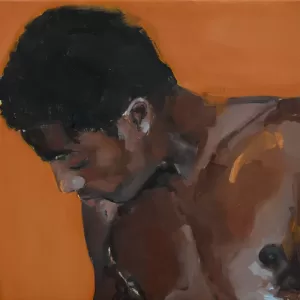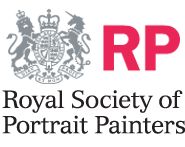
Kudzanai-Violet Hwami, ‘Stan 4.’
ESSAY:
The Maker of Ghosts
Kudzanai-Violet Hwami’s art is fixated upon the pull of distance. Her first institutional show, held four years ago at Gasworks, London, was titled ‘(15, 952 km) via Trans–Sahara Hwy N1’ in reference to the route between Hwami’s hometown in Zimbabwe – the country she was compelled to leave at nine years old amidst political turmoil – and London, where she has spent her adult life. She painted canvases populated by the people she met upon her return visit, as well as intimate, domestic imagery from old family photo albums. Though both Hwami’s relationship to the subjects and the source material varied, each was processed through the artist’s painterly matrix and reproduced as an obscured or partial portrait. The figures were disparate but united by fragmentation: likenesses complicated by uneven blocks of solid, bright colour or flickering with abstract shapes. The outcome was a body of paintings awash with memories simultaneously inaccurate and vivid. The artist’s most recent show, ‘A Making of Ghosts’ (14 April–20 May 2023) at Victoria Miro, London, moved away from geographical displacement but continued to explore the tethers and tricks of memory.
Hwami’s painted portraits are ablaze with colour. ‘A Making of Ghosts’ contained a series of colourful figurative artworks often depicting the artist’s family or friends, sometimes unidentified nude sitters. Black figures are set against a background of or cut through with solid streaks of cobalt blue or scarlet red, as in the striking Resting man on red earth (2023) in which a monumental nude lies curled on his side amid swathes of jagged colour bands. These vivid canvases, in a mixture of oil and acrylic, were grouped in clusters alongside figurative works in other mediums, often mixed or collaged. This was most effective in the room-high, monochromatic photographic prints which sliced the viewer’s eyeline, trailing on to the floor like giant, unravelled film strips (as in Burning woman, 2023) or dangling in perfect stillness two feet above the ground. Together, these groupings exaggerated the themes of fragmentation at play within the individual pieces, each artwork representing a shard within a larger fistful of splintered imagery.
The works felt dislocated, unmoored. Groupings were loosely tethered together in a way that foregrounded the artist’s interest with the act and fallibility of image-making. This sense of slippage was most apparent in the collection of works that greeted visitors as they entered the ground floor gallery. Pasted onto a wall was a monumental black and white photograph of the back of a man’s head. He seemed to be walking, just ahead of us, through a sparse field in bright, hot daylight, perhaps somewhere in the artist’s native Zimbabwe. The collar of his shirt was dirty, the fabric of his cap tattered. The large photograph was flanked by two brightly coloured canvases, one much smaller than the other, on which were painted overlapping images of naked male figures (Stan 4 and Murikishi, both 2023). As in the photographic portrait, we cannot see the two painted figures’ eyes. They appear to avert their gazes: one looking downwards, the other caught like a mistimed photo with eyes blinking shut. They do not notice we are looking at them or they do not care. Unlike in the photographic portrait, they are flagrantly naked. Chests bared and legs comfortably open, theirs is the casual sensuousness of men at ease with the eroticism of their bodies. Hookup profile pictures glitching with streaks of paint.
The relationship between the photograph and two small paintings felt intentionally evasive. Positioned as though in a trinity, the nude men were stationed like diminutive idols guarding the image of a central deity whose face we are unable to see – the playful, cherubic gatekeepers of an austere icon. Or they might have been read as the modern children of a rural ancestor, their identities recorded through thirst trap selfies both literally and metaphorically miles apart from the generations before them. Regardless of the interpretation, the relationship between the three works was constantly underpinned by a sense of distance. The elusiveness of the meaning became key to its message.
Toying with faint connections and memory’s sleight of hand, Hwami’s work curiously pursues its subjects as if following a glimpsed figure through an empty house. As viewers, we seek to find connections and to assemble a narrative. It is this desire which the artist anticipates and expertly exploits. The portraits each contain enough information for the viewer to begin constructing a sense of place, of character or of atmosphere: dishevelled clothing, the sense of physical closeness to the man who walks but a step ahead of us, the paintings’ eye-catching colours, the barely-there nudes. And yet there is not sufficient detail for a conclusive understanding of what we are seeing. Just as the compositions are motivated by memory’s evasive character, so too do the finished works tantalise the viewer.
Not satisfied with depicting spectral figures and elusive scenes, it seems that Hwami also wants to lay bare the process of the images’ making. The collage-like visuals of her spliced compositions demonstrate, through form rather than content, the act of assembling. The ‘making’ of the show’s title points not just to memory as the maker of ghosts, but also to herself, the artist whose splintered canvases allow figures to take form. Instead of using her artwork as a fictional arena in which the complications of reality – that memory is always distorted, that our sense of self is inherently contradictory – are suspended, Kudzanai-Violet Hwami utilises these fallibilities to fashion incisive tools from which her striking portraits derive their impact.
To stay in touch and hear the latest news please subscribe to our newsletter

